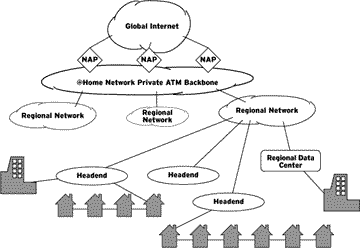@Home's network is designed on the fundamental premise that sustainable high performance requires a new, highly scaleable architecture that removes Internet "traffic jams" and enables true end-to-end performance management. This goal is achieved not just by "working harder" with a bigger pipe, but by "working smarter" with a performance-engineered, intelligent network as well.

With daily headlines like "No Shortage of Bottlenecks on the Information Superhighway," "Explosive Growth Clogs the Internet's Backbone," and "online Downtime Gives Web Surfers the Blues," it is clear that the general Internet is plagued with performance limitations. Bob Metcalfe, developer of Ethernet and noted columnist, has even gone so far as to predict the Internet's impending "catastrophic collapse" due to surging demand and increasingly frequent black-outs and brown-outs. Given the sheer number of bottlenecks and the Internet's decentralized nature, it is unlikely that there will be a significant improvement anytime soon.
To overcome the performance limitations of the Internet, @Home Network has developed a high performance "parallel Internet" (effectively one of the world's largest intranets). While it uses the same underlying protocols to ensure compatibility and seamless access to everything on the Internet, @Home's network architecture is markedly different.
@Home Network delivers its services over a high-speed backbone which links into existing fiber optic and coaxial cable systems (also known as hybrid fiber-coax or "HFC"). Residential customers access the network via high-speed cable modems, which attach to their personal computers with a standard Ethernet connection. @Home's unique high-speed network that sits between its customers and the Internet provides a significant competitive advantage—enabling dramatically better performance, higher quality of service, and greater functionality than is possible over the general Internet.
Two key themes in @Home's network strategy are "pushing data closer" and "end-to-end management." To embody the first theme, @Home Network uses a hierarchical, distributed network architecture with proprietary caching and replication technologies to ensure that information a customer wants is always "as close as possible" within the network.
Pushing data closer resolves one of the Internet's fundamental architectural weaknesses, and the cause of many of its current performance issues – highly redundant data traffic. When you download a video clip from CNN's Web site, for example, you pull those bits all the way across the Internet from CNN's Website, to their ISP, through potentially multiple interchanges on the Internet backbone, to your ISP, and finally to your computer. If your next door neighbor requests the very same video clip from CNN, she also pulls it all the way across the country, across the Internet backbone, on a similarly convoluted path. The result is that many of the same bits inefficiently traverse the general Internet backbone over and over and over.
@Home Network's approach, in contrast, moves that video over its high-speed backbone only once and retains it in an @Home cache close to your home – becoming efficient "local traffic" provided by a local server when either you or your neighbor view it. Put simply, @Home's philosophy is to "never move the same bits twice."
This improved efficiency provides @Home Network members with significant speed and reliability by drastically reducing the need for them to traverse the global Internet to get information. In addition, it dramatically reduces traffic volume (and corresponding costs) across the backbone, since data is usually available nearby.
Media companies working with @Home Network can achieve a massive bandwidth advantage over the general Internet by using @Home Network's caching, replication, and hosting features. These features also considerably reduce the companies' server hardware and communications expenses by efficiently distributing their traffic volume across the network.
The second theme, "end-to-end management," describes @Home's proactive network quality, service, and performance management systems. The network architecture provides management visibility from @Home's servers (or a content partner's servers) all the way to the customers' PC. Because the network is centrally managed, @Home can avoid the "finger pointing" that plagues the general Internet, and instead dynamically identify and address network quality, service, and performance issues before they ever affect users.
The primary components of @Home's network include the ATM Backbone, Regional Data Centers, Local Caching Servers, Cable Modems, and the Network Operations Center.

